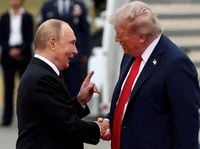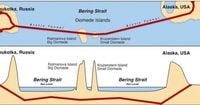In a move that’s turning heads on both sides of the Pacific, a Kremlin-backed proposal to build a massive undersea tunnel connecting Russia and Alaska has sparked debate, curiosity, and a healthy dose of skepticism among world leaders and the public alike. The ambitious plan, floated by Kirill Dmitriev, President Vladimir Putin’s investment envoy and head of Russia’s sovereign wealth fund, envisions a 70-mile (112-kilometer) rail and cargo tunnel running beneath the frigid waters of the Bering Strait. If realized, it would be the first physical link between the continents of Eurasia and North America—a feat never before accomplished in human history.
The idea was thrust into the international spotlight on October 16, 2025, when Dmitriev took to X (formerly Twitter) to share his vision for what he dubbed the “Putin-Trump Tunnel.” Tagging U.S. billionaire Elon Musk, Dmitriev suggested that Musk’s tunneling venture, The Boring Company, could bring the project to life. “Let’s build a future together!” Dmitriev wrote, pitching the tunnel as a “symbol of unity” and touting a price tag of less than $8 billion—far below the $65 billion typically estimated for such a colossal undertaking, according to the Moscow Times and Russia’s TASS news agency.
“Imagine connecting the US and Russia, the Americas and the Afro-Eurasia with the Putin-Trump Tunnel—a 70-mile link symbolizing unity,” Dmitriev posted, attaching a sketch from the Cold War era that depicted a similar vision, the so-called ‘Kennedy-Khrushchev World Peace Bridge.’ “The time has come to do more and connect the continents for the first time in human history,” he added, referencing the decades-old dream of bridging the Bering Strait.
The timing of Dmitriev’s proposal was no accident. Just hours before, U.S. President Donald Trump and Russian President Vladimir Putin had held a two-hour phone call to discuss potential resolutions to the ongoing war in Ukraine. The two leaders are slated to meet in Budapest within the next two weeks to explore peace talks further, as confirmed by both the Kremlin and the White House, according to USA TODAY and Reuters. In the meantime, Trump hosted Ukrainian President Volodymyr Zelenskyy at the White House on October 17, where the tunnel proposal quickly became a topic of conversation.
Trump’s initial reaction to the idea was characteristically noncommittal but tinged with intrigue. “That’s an interesting one,” he told reporters during the Oval Office meeting with Zelenskyy. “We’ll have to think about that.” Turning to the Ukrainian leader, Trump asked, “What do you think of that, Mr. President? Do you have any ideas? How do you like that idea?”
Zelenskyy, whose government has been locked in a bitter conflict with Russia for more than three years, didn’t mince words. “I’m not happy with it,” he replied. Trump chuckled, telling the press, “I don’t think he liked it.” The exchange underscored the deep mistrust and “bad blood” between Moscow and Kyiv, as Trump himself put it, even as diplomatic efforts for peace continue.
Dmitriev’s vision for the tunnel is grand, but it’s not without historical precedent. Proposals to connect Russia and Alaska have circulated for over 150 years, dating back to the days of the telegraph and the gold rush. During the Cold War, U.S. and Soviet leaders briefly entertained the notion of a “Peace Bridge” to symbolize detente. Dmitriev referenced this legacy in his social media posts, arguing that modern technology—specifically The Boring Company’s “Zero-People-in-Tunnel” approach—could finally make the dream a reality.
The potential benefits, Dmitriev claims, are substantial. The tunnel would serve as a railroad and cargo link, unlocking joint exploration of natural resources in the Arctic and creating new jobs on both sides of the strait. He even floated the possibility of trilateral cooperation between Russia, the U.S., and China in Arctic hydrocarbon projects, as reported by TASS. “Certainly, Russia is eyeing the opportunity of joint Russia-China-US projects, including in the Arctic region, specifically in the energy sector,” Dmitriev said.
Yet for all its promise, the project faces daunting obstacles. The Bering Strait is notorious for its brutal weather, seismic activity, and complete lack of supporting infrastructure. The region’s only settlements are the tiny Diomede Islands, separated by just 2.4 miles but representing a yawning gap in logistics and governance. The Boring Company, for its part, has never attempted a project in such extreme conditions. Its previous tunnels have been dug in hot, dry, urban environments—worlds apart from the icy, earthquake-prone Arctic.
The Boring Company also brings baggage of its own. According to ProPublica and CNBC, it was recently fined by Nevada environmental regulators for a litany of violations, including digging without approval and spilling waste. Its current 10-mile tunnel project in Nashville, Tennessee, has faced local protests over planning and environmental concerns. Whether Elon Musk is willing—or able—to take on a project of this scale and risk remains an open question. As of Friday evening, Musk had not publicly responded to Dmitriev’s overtures.
There are also geopolitical and economic questions. The tunnel, Dmitriev argues, could “unlock joint resource exploration,” but with U.S.-Russia relations at their lowest point in decades, many in Washington and beyond are wary of deeper economic entanglement. The project’s branding as the “Putin-Trump Tunnel” is itself a political lightning rod, sure to provoke debate among both supporters and critics of closer U.S.-Russia ties.
Meanwhile, Arctic nations—including Russia—are already accelerating mining and drilling operations as climate change melts polar ice, opening new shipping routes and resource frontiers. The tunnel could theoretically facilitate this “Arctic gold rush,” but environmentalists and indigenous groups may have their own say. The region is home to fragile ecosystems and communities with deep historical ties to the land and sea.
For now, the tunnel remains just an idea—a bold, perhaps quixotic vision of unity at a time of division. Trump, ever the dealmaker, is keeping his cards close to his chest, while Zelenskyy’s blunt opposition reflects the harsh realities of war and mistrust. Dmitriev, undeterred, continues to champion the project as a new chapter in global cooperation, invoking the spirit of Kennedy and Khrushchev, and now, Putin and Trump.
Whether the world will see trains rumbling beneath the Bering Strait anytime soon is anyone’s guess. But one thing’s for sure: this proposal has reignited a conversation about what’s possible—and what’s at stake—when nations dream big, even as they clash on the world stage.





